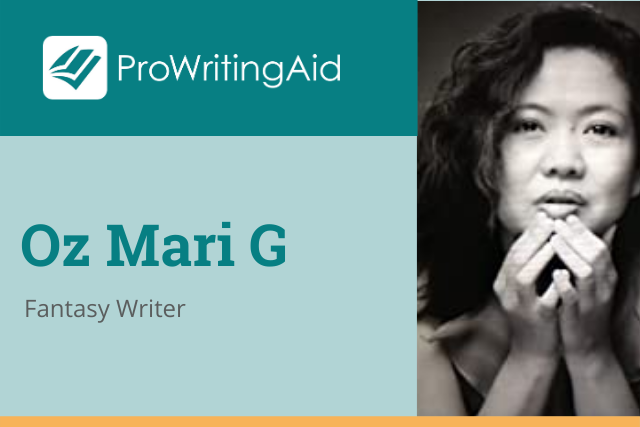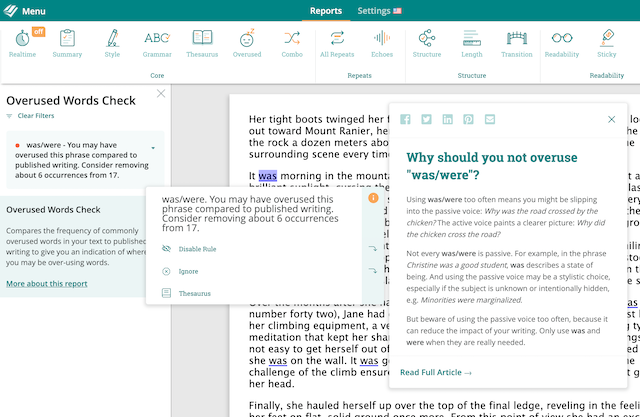
There are all kinds of writers in the ProWritingAid community, all with very different writing styles.
Author Oz Mari G. shares how ProWritingAid helped her get through three rounds of rewrites before she published her first novel.
About Oz Mari G.
A storyteller from childhood, Oz Mari G. became an entrepreneur and a proud sales professional when she grew up, but remained a story lover to her core. This year, she finally stopped dillydallying and answered her calling to become a writer, and now responds to Oz Mari G., her pen name.
My Background
If you had asked me to describe who I was months before the pandemic, I would have told you I was an entrepreneur, a proud sales professional, a mother, and a woman who loved books. “Writer” would not have been a title I’d have put on my CV.
But the quarantine took away the usual outlets for my creative energy. My sister asked me to write a concept for a Netflix series, and with nothing better to do, I agreed. This seemed a little out of the blue at the time, but when I look back on it, it wasn’t random at all.
I used to write stories when I was young. I love storytelling. I used to collect fairy tales. I joined the corporate world after university because I thought that authors couldn’t make any money. At that point in my life, making money was more important than doing what I really loved.
Halfway through the writing process, I realized that my idea was too big to be contained in a few episodes, so I took a leap of faith and decided to write an entire book. As I wrote and wrote, the story grew and grew until I knew that one novel was not enough. The one-book project became a trilogy, and the writing process gave birth to many other ideas for various novels within the same fantasy world.
Three months into writing the first book, I finally realized that writing—creating characters and building worlds—was what really made my heart sing. It was then that my “one day” dream of becoming a writer after retirement became my here-and-now career plan.
My Writing Goals
This change in my path did not mean my extensive business and sales background just flew out the window. I had years of experience in the field and countless hours of sales training entrenched in my system. I was not content to simply tell stories. Being a great writer became a driving urge. At the same time, my practical side wanted my books to become an economic success. This meant two things: One, I would have to become the best writer I could, and two, I would have to learn how to market, promote, and sell my books.
I didn’t relish the idea of going back to school to learn how to write, so I researched training opportunities online. This led to falling down a lot of YouTube rabbit-holes and participating in tons of webinars to get as much exposure as I could. Attending ProWritingAid’s monthly Write-In webinars helped me feel part of a writing community and encouraged me to think about my ideas, scenes, and characters in new ways.
For my second goal, I threw myself into studying how the industry works. Again, this required a lot of research, more webinars and binge-watching of how-to videos. My career as a tech entrepreneur told me that finding the right digital tools would be vital to building a strong writing process. I am a firm believer in using apps and programs to simplify processes where possible so that I can focus on what I really love: the creative writing process.
My Writing Process
My business background means that I love having a system. I’ve repeatedly seen how a systematic approach creates efficiency and generates more time to be productive. Here, my aim was to make as much time as possible for the actual writing.
Like most writers, I would rather spend all of my time creating, nurturing ideas and putting them down on paper. But I knew that I couldn’t just write for myself—my goal was to become a brilliant writer and sell books. And I’d learned that if I wanted to sell books, my readers’ preferences and tastes were just as important as my own, if not more.
It was crucial for me to establish a systematic process very early on so that I could keep track of how my book was taking shape. So, I established a workflow.

The Rough Draft
First, I roughly outlined the book concept. Then I wrote certain plot points as a guide. After that, I typed the events as if it was happening in my head. I had decided to write as much as I could without worrying about form, grammar, or structure. The goal was to write the story first and polish it later. The end product was my Rough Draft. And people, it was rough.
English is my second language, so you can imagine the tangle that was my prose. It was a web of changing POVs, alternating tenses, redundant and repetitive sentences. I crafted my dialogue to reflect how I speak in real life—I was unaware I sounded like a pretentious bitch until I read it back to myself.
Now I had that first rough draft, it was time to self-edit my material. I knew the value of getting feedback on my work. It was imperative if I was to come out of this process with a splendid book. But I knew I couldn’t just foist the rough draft on potential Beta Readers. If they had to point out endless grammar, spelling, and style errors, they wouldn’t have time to give meaningful feedback on the actual meat of my story: the plot, characterization, pacing, and overall structure.
The First Draft: Self-Editing for Readability
This meant I would have to edit it ruthlessly. This is where ProWritingAid came in, and by god, it was such a valuable tool.
The first time I uploaded my work to ProWritingAid was a hallelujah moment—it floored me with the amount of blue, red, and yellow flags in my manuscript. And that was just the grammar, spelling, and style issues. I was so impressed with what it could do that I immersed myself in correcting everything the app found wrong in my material. The app showed me how prone I was to using weak adverbs and splitting infinitives. I learned so much about the way I write by thinking deeply about each suggestion it gave and the impact it had on my writing.
My favorite ProWritingAid feature is the Readability Report. It was important to me that my book was easy to read. The report highlighted each of my paragraphs, showing me how readable (or not!) they were. This helped me prioritize areas for rewriting so that I could make quick improvements to my overall Readability score. Once I knew where I needed to improve readability, I moved on to the other reports to help me take action.
The Overused Words Report pointed out widely used but weak words I kept repeating in the document. That forced me to compose my sentences and paragraphs precisely and with variety. I was starting to see how taking the time to pick the right words could transform a scene.
I had a penchant for overusing “felt” in my narrative, which indicated that I was telling my readers what was going on in my characters’ heads rather than showing them. Searching out all of the times I used “felt” helped me to hone in on the emotions I wanted to get across in each scene, making my prose more impactful.

ProWritingAid is a brilliant tool to help you organize your editing and look at your writing in new ways, but it still requires your input. You have complete control over whether you accept suggestions or not, and that means that your individual voice can still shine through. I know that ProWritingAid is going to be a valuable tool for improving my writing for a while yet. I still have the tendency to write passive sentences when they should be active, for one thing!
Reading Aloud and Beta Reading
After self-editing came what I call the Read-Out process. I began by reading my work aloud to myself. I winced at the cringey dialogue every time. My voice got tired after a while, so now I use an app called EditOutLoud. As the name suggests, it read my manuscript aloud for me. This highlighted where I might need to break up long and winding sentences, further improving their readability. What followed was another round of rewrites. My manuscript went back to ProWritingAid for another run-through, checking my sentence lengths, readability, and spelling one more time. This resulted in my first draft, and this was the version I let loose on my Beta Readers.
I was confident enough by this point to send it to my old high school English teacher. I was proud to see that in the 90,000 words I sent her, she only underlined three sentences, and corrected eleven spelling mistakes, which weren’t mistakes at all. (She was used to American spelling, and I used British English. Running the document through The Consistency Report in ProWritingAid reassured me that I hadn’t mixed American and British English throughout my text.)
The Beta Reading phase took a few weeks, so I had to be patient. This was difficult for someone like me, so I occupied myself during this period recruiting as many Beta Readers I could find. If you’re recruiting from your circle of friends and family, you might want to avoid doing this close to your birthday or any special holidays. I suspect I got written out of several Christmas lists because I was constantly following up and rushing them to read the book!
My next task was reviewing the feedback I received from my Beta Readers. I picked out the valid points that I thought would improve my manuscript the most. These were comments about the story arc, worldbuilding, and character arcs. This meant more rewriting.
The Second and Third Drafts: Story Editing
I gutted my first draft, rewriting entire chapters and discarding about twenty percent of what I had already written. This was hard, but I was very pleased with the result. My book was more compelling by the end of the exercise. I used another app called Fictionary for this phase.
Fictionary is a story editing tool that the ProWritingAid team recommended to me during various webinars they organized this year. This program broke down my manuscript on a scene-by-scene basis and allowed me to see how my story arc flowed. It clearly identified which scenes were necessary (scenes which move the plot forward), which scenes were strong, and which ones were weak.
This process required—you guessed it—another round of rewrites. I ran the material through ProWritingAid again, just because I wanted to make sure my modifications were in the same tone and style as the rest of the document. The ProWritingAid Style Report was a great help with this. This process brought me to my second draft.

I sent out this edited manuscript to my previous Beta Readers and an additional set of Beta Readers for an authentic reaction. Just like the first time, I picked out the comments and suggestions I thought would improve the book further. This time, it was about adding more of an emotional hook to my story. I relied on the ProWritingAid Sensory Report, which helped me make sure I was using all five senses throughout my manuscript to draw my readers in. This round of rewrites yielded my third draft.
Learning the Craft
All this editing and rewriting would have broken my spirit if it hadn’t been for ProWritingAid. The program became the second set of eyes I needed to make up for the blind spot I have for my own material. It also cut down on the time I would have otherwise spent in reading the manuscript over and over.
By now you’ll realize, just like I did, that being a writer is difficult. All the experts (successful authors, agents, publishers) will tell you the key to a brilliant book is constant rewriting; and the secret to becoming a great writer is continuous education in the craft. You’ve got to read a lot of books to write a book.
Like I mentioned earlier, I didn’t want to go back to school to learn about writing, and all that reading takes a lot of time. But I still needed to learn. Webinars are another great way to learn about every area of the process while still feeling connected to other writers. ProWritingAid has several monthly sessions I always attend—even if they’re at two or three a.m. in my time zone. I believe the quest to become a brilliant writer is a never-ending endeavor, and I felt that joining these live sessions gave me opportunities I couldn’t miss.

The ProWritingAid webinars gave me free tips and referrals to certain tools and individuals I needed to improve my skills and my book. That includes professional editors, agents, writing mentors, and book marketers. For a self-published author like me, when the cost of a professional editor can be prohibitive, I need to employ all the tools and resources I can to make my manuscript as polished as possible by myself. ProWritingAid hosts monthly write-in webinars where you can share your work, learn new skills, and get feedback from other writers on short pieces of your writing. Their Q&A sessions with experts on everything you need to know to perfect your craft and sell your books have been invaluable.
The Final Draft: Looking Forward
I published the first book of my series, Rise of the Viscerebus, last July on various digital platforms like Amazon, Apple Books, Baker & Taylor, Barnes and Noble, Bibliotheca, and Kobo, among others. I decided to publish under a pen name, Oz Mari G. My real name felt too connected to my past life in business, and didn’t suit the genre I wanted to immerse myself in.
Now, I have earned enough from my first book that my next step is to hire a marketing expert to get the word out there. Excitingly, a script is currently in development for a movie based on the main character and the world I created. I reviewed the first draft with the screenwriter a month ago, and can’t wait to see where this new path takes me. The second draft is underway, and I’m hopeful the promotion of the book and the movie will lift each of them to new heights.
Writing is hard. Being a good writer is harder. And being a financially successful one is hardest. We need all the help we can get and should use every tool we can find to make the process easier. This is what will allow us to keep on doing what we love—writing the stories that live in our hearts and sharing them with the people who might love them too.
I hope I have helped shed some light on the writing process. And you can bet that I ran this article through ProWritingAid! I didn’t want to submit any material to their blog that hasn’t gone through the same rigorous process as my book.
If you have any questions, you can contact me at gogranlund@gmail.com or follow me on Facebook, Twitter, and Instagram.
My book can be purchased on Amazon and Books2Read.


